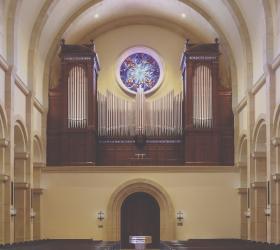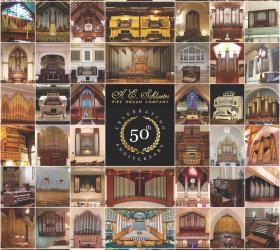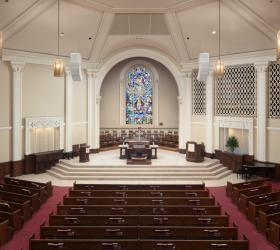
C. B. Fisk, Inc., Gloucester, Massachusetts, Opus 124
Christ Episcopal Church, Roanoke, Virginia
The new organ at Christ Episcopal Church, Roanoke, Virginia, is Opus 124 of the Fisk firm: two manuals, 38 ranks housed in a mahogany case. Charles Nazarian, design consultant, developed the visual design of the organ with members of the Fisk shop, and in consultation with the organ committee.
The mechanical key actions for Opus 124 were made simple and direct to reduce the literal and figurative distance between musician and music. Some of the largest pipes are pneumatically controlled to preserve the lightness of touch. The Swell division was placed high in the case, with its pipes arranged from back to front in the 19th-century French style. The Great division was placed below and to each side to speak boldly into the nave. The manual divisions are winded from a single large wedge bellows to provide a unified breath for music requiring a flexible wind supply; a stopknob may be drawn to engage an integrated system of wind stabilizers. The mechanical stop action ensures maximum longevity for the instrument.
Rooted firmly in historic principles, Opus 124’s stoplist is a blending of elements representing several centuries of the most noteworthy schools of European organbuilding. If there is a strong nod in the direction of 19th-century Parisian builder Aristide Cavaillé-Coll, it is because in his work one finds the diversity, integrity, drama, and expressiveness of tone most becoming to the modern-day Episcopal worship service. The Hymnal 1982 and its many supplements resolutely celebrate all of these musical qualities; the sacred choral repertoire comes to life when supported by such rich, sharply defined, symphonic sounds.
Pipe scalings, pipe metal alloys and surface treatments, pipe constructions, and voicing techniques all follow historic precedents. One interesting example is the tapered, hammered lead Spillpfeife 8' on the Great; it is modeled after the elegant Spillpfeife found in the Hauptwerk of Friedrich Stellwagen’s 1637 transept organ at the St. Jakobikirche in Lübeck, Germany. Standing beside it on the Great windchest of Opus 124 is the hammered tin Violoncelle 8', scaled and voiced after Cavaillé-Coll’s numerous Violoncelle stops; the pipe bodies are overlength with tuning slots à pavillon in the French style, and the pipe mouths are fitted with Cavaillé-Coll’s singular harmonic bridges, or freins harmoniques, all of which contribute to the pipes’ characteristically rich, edgy timbre. The instrument is also home to a quartet of Cavaillé-Coll-inspired harmonic flutes. Due to their double-length construction, these flutes are voiced to sound their first, or octave, harmonic; this results in a very pure, slightly breathy tone with potential for great power in the treble range. The large-scaled Flûte harmonique 8' in the Great division, singing and voluptuous in tone, takes full advantage of this potential as the instrument’s primary solo flute. In contrast, the Swell Flûte traversière 8', of moderate scale, is voiced to be imitative of an orchestral traverse flute. Together with the Swell Flûte octaviante 4' and Octavin 2' it forms a chorus of harmonic flutes, all under expression—an indispensable combination for 19th-and 20th-century French repertoire, and ideal for choral accompaniment.
All told, the Great and Swell divisions contain seven 8' flue stops of widely varying timbres. When drawn together they form what the French refer to as the fonds d’huit, or 8¢ foundations, a combination of stops frequently called for in 19th- and 20th-century scores. What is unusual about Opus 124’s fonds combination is that every one of the voices is open and full-length (or harmonic and double-length), resulting in a sonority of extreme opulence and depth.
The organ’s five reed stops are also worthy of note. The Great Trompette 8' is modeled after the Trompette stops of 18th-century French organbuilder François-Henri Clicquot and exhibits the free-wheeling, bass-heavy brashness of that builder’s reeds. The Swell Trompette 8' and Hautbois 8' are both modeled after Cavaillé-Coll and are therefore more restrained, refined, and vocal. The Swell also contains a German reed, the Dulcian 16', whose construction and voicing are based on a stop found in Arp Schnitger’s famous 1670 instrument in the St. Cosmaekirche in Stade, North Germany. It adds another dimension to the otherwise French Swell division and allows for very convincing performance of Renaissance and early Baroque repertoire. The Pedal Posaune 16' is a full-blown, large-scaled Schnitger reed and provides a powerful, foundational underpinning to large combinations on the manuals.
The temperament is the mildly unequal Fisk II, which, while favoring the common keys, allows for music of all styles to be performed. Wind pressures are 3≤ water column for the manual divisions and 4≤ for the Pedal.
David C. Pike, tonal director
Gregory Bover, project manager
Photo credit: Thomas Baugh
GREAT (58 notes)
16' Prestant
8' Octave
8' Violoncelle
8' Spillpfeife
8' Flûte harmonique
4' Octave
4' Offenflöte
2' Superoctave
Mixture IV–VI
Grand Cornet V (c1– f3)
8' Trompette
SWELL (58 notes, enclosed)
8' Diapason
8' Viole de gambe
8' Voix céleste
8' Flûte traversière
4' Principal
4' Flûte octaviante
22⁄3' Nazard
2' Octavin
13⁄5' Tierce
Plein jeu IV
16' Dulcian
8' Trompette
8' Basson et Hautbois
PEDAL (30 notes)
16' Prestant (Great)
16' Bourdon
8' Octave (Great)
8' Violoncelle (Great)
8' Spillpfeife (Great)
4' Octave (Great)
16' Posaune
8' Trompette (Great)
Couplers
Swell to Great
Great to Pedal
Swell to Pedal
Swell Super to Pedal
26 voices, 38 ranks, 1,910 pipes
Wind: stable, flexible, tremulant
Key action: direct mechanical except for certain large bass pipes
Stop action: mechanical
Keydesk: built into the case, two manuals and pedals; manuals 58 keys CC–a3, naturals of grenadil, sharps of rosewood capped with cowbone; pedalboard 30 keys CC–f1
Casework: a single cabinet of Honduras mahogany, free standing in the front of the sanctuary; front pipes of polished hammered spotted metal




